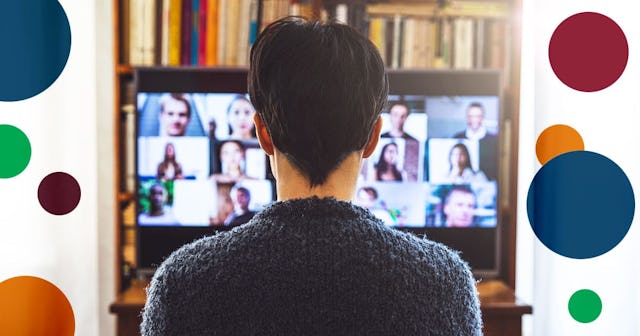New Study Gives Actual Reasons Why You Can't Stand Zoom Now

Turns out, there’s a scientific reason you hate Zoom
We’re a year into the pandemic, almost a year of family celebrations canceled or seriously altered and we’re wearing masks until further notice. While the vaccine is rolling out across the nation, we’re still social distancing, so business is most definitely not going on as usual. Which means Zoom meetings are here to stay. It’s been a year of asking other participants to mute themselves or unmute themselves. A year of learning more about our colleagues decorating preferences than we ever thought possible. And we’re sick of it. And a new study says there’s actually a good scientific reason (four actually) why you are absolutely over Zoom.
Jeremy Bailenson of the Stanford Virtual Human Interaction Lab recently published a study on the mental impact of spending hours per day on Zoom and other popular video chat platforms.
The result: Four problems that Bailenson says stems from a year of video calls. Or what we commonly refer to as “Zoom fatigue.”
Four reasons you hate Zoom
Problem: Extreme amounts of close-up eye contact is intense.
The amount of eye contact we enter into on video chats, as well as the size of faces on monitors is abnormal. In a typical conference, people will look around the room. But on Zoom calls, everybody is looking at everyone — all the time. Listeners become speakers because people are staring at you even when you don’t speak.
Solution: Bailenson recommends switching Zoom out of the full-screen option and decreasing the size of the Zoom window. He also suggests using an external keyboard to allow an increase in the personal space bubble between oneself and the grid.
Problem: Prolonged episodes of watching yourself on video is fatiguing.
Most video platforms display a square of what you look like on camera during a discussion. But that’s unnatural, Bailenson said. “In the real world, if somebody was following you around with a mirror constantly — so that while you were talking to people, making decisions, giving feedback, getting feedback — you were seeing yourself in a mirror, that would just be crazy. No one would ever consider that,” he added.
The disconnect is jarring and unrelenting — and can extend to our voices, as one Twitter user notes.
Solution: Bailenson proposes video conference platforms modify the default practice of streaming the video to both presenters and viewers, when it only needs to be sent to viewers. Presenters can use the “hide self-view” button, which you can do by right-clicking your own photo.
Problem: Video chats considerably lowers our ability to move.
In-person and phone chats allow people to move. But with Zoom, most people have to stay in the same spot or the camera focus gets thrown off. This means your movement is limited in ways that don’t feel natural.
Solution: Bailenson recommends people consider the room they’re chatting in. Sitting away from the screen will allow you to walk and doodle in virtual conversations just like we do in face-to-face meetings. Also, you can turn off the video every now and again — it will give you a short nonverbal rest.
Problem: The cognitive load is much higher in video chats.
Bailenson notes that in typical face-to-face interaction, nonverbal communication is natural. But in video conversations, we work harder to convey and receive signals. The study states that gestures could mean different things in a video context. A sideways glance to somebody during an in-person meeting signifies something very different than an individual on a chat grid looking off-screen to their dog who just started scratching on the door.
We can all relate — it’s exhausting to constantly scan and think of nonverbal communication.
Solution: During long stretches of meetings, make sure to give yourself an “audio-only” break. “This is not simply you turning off your camera to take a break from having to be nonverbally active, but also turning your body away from the screen,” Bailenson said, “so that for a few minutes you are not smothered with gestures that are perceptually realistic but socially meaningless.”
Bailenson is continuing his research on video exhaustion. If you are interested in measuring your own Zoom fatigue, you can take the survey here and take part in the research project.
What say you? Do you experience Zoom fatigue?
This article was originally published on